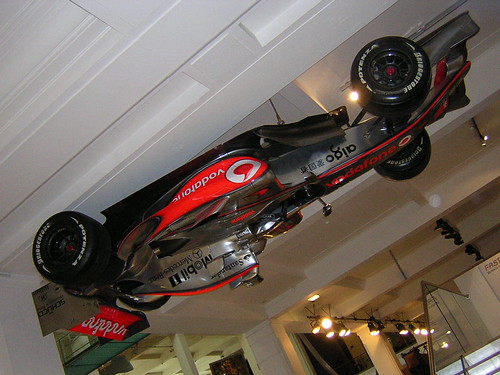
Science Museum: Formula 1
It's rare to find a recent Formula 1 (F1) car in a public museum, even rarer is to see an F1 car hanging upside down from the ceiling, yet you'll find both at the London Science Museum. Finally I'm at the end of my Science Museum grand tour - though it only took an afternoon in real time, it has spawned weeks worth of blog posts and covered a century of innovation - spanning computing, rockets, VTOL, British WWII Airplanes, wind tunnel models and now F1.
At the end of each F1 season the current crop of F1 cars are instantly obsolete. So to find F1 cars in a museum should be a common occurrence. The fact that it isn't is due to the second-hand value of F1 cars making them prime targets for wealthy collectors and their private collections (museums). The last batch of F1 cars to face retirement (from the 2008 season) were more obsolete than most given the drastic rule changes introduced for the 2009 season. The new 2009 cars are markedly different in appearance due to new aerodynamic restrictions and the re-introduction of slick tires. You can bet that much of the new appearance was finessed by performing round-the-clock Computational Fluid Dynamics (CFD) calculations and wind tunnel tests in the off-season.
The diffuser on an F1 car is a significant source of downforce, and downforce is the key ingredient in negotiating the twisty race circuits found in the F1 championship. Each team keeps its diffuser design a closely guarded secret, which is aided by the fact that the diffuser is not directly visible while a car is on the ground. Any details of a diffuser are usually hard earned, unless you happen to come across an old design on view in a public museum as I did. In the 2009 F1 season a controversy based on the interpretation of the new rules governing the diffuser erupted and has meant a complete turnaround in the fortunes of some of the best and worst teams from the 2008 season.
 Mini: The star of the Italian Job
Mini: The star of the Italian Job
Now why would you mount an F1 car upside down on the ceiling of a museum? I think it's to highlight the fact that the amount of downforce generated by an F1 car at full speed exceeds the weight of the car acting under gravity. This means that once you get an F1 car up to speed you could drive it upside down on the ceiling of a tunnel. So instead of the Minis in the Italian Job (1969 version) just swaying from side to side in the sewer tunnel on their escape from Turin, an F1 car could invert and zoom along the ceiling.
Recent blog posts
- CFD Simulates Distant Past
- Background on the Caedium v6.0 Release
- Long-Necked Dinosaurs Succumb To CFD
- CFD Provides Insight Into Mystery Fossils
- Wind Turbine Design According to Insects
- Runners Discover Drafting
- Wind Tunnel and CFD Reveal Best Cycling Tuck
- Active Aerodynamics on the Lamborghini Huracán Performante
- Fluidic Logic
- Stonehenge Vortex Revealed as April Fools' Day Distortion Field


